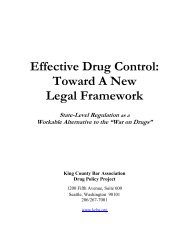Significant Developments in the Law of Evidence and Civil Procedure
Significant Developments in the Law of Evidence and Civil Procedure
Significant Developments in the Law of Evidence and Civil Procedure
You also want an ePaper? Increase the reach of your titles
YUMPU automatically turns print PDFs into web optimized ePapers that Google loves.
The court did note a rul<strong>in</strong>g by <strong>the</strong> trial court that H would be allowed to testify from memory because<strong>the</strong> messages were ―ak<strong>in</strong> to verbal statements‖ by D.Author’s commentsWith Thompson <strong>and</strong> cases cited <strong>the</strong>re<strong>in</strong>, <strong>the</strong> rules <strong>of</strong> evidence with respect to text messages <strong>and</strong> e-mails may be summarized as follows.1. The message must be relevant to be admissible.2. The message must be au<strong>the</strong>nticated to be admissible. Most courts, <strong>in</strong>clud<strong>in</strong>g Thompson, have appliedtraditional pr<strong>in</strong>ciples <strong>of</strong> au<strong>the</strong>ntication as def<strong>in</strong>ed <strong>in</strong> Rule 901, mak<strong>in</strong>g <strong>the</strong> process <strong>of</strong> au<strong>the</strong>nticationrelatively easy. The proponent is required only to present a prima facie show<strong>in</strong>g <strong>of</strong> au<strong>the</strong>nticity. Thereafter,challenges to au<strong>the</strong>nticity go to weight, not admissibility.A few courts have established special, more rigorous requirements for <strong>the</strong> au<strong>the</strong>ntication <strong>of</strong> text messages<strong>and</strong> e-mails.The Wash<strong>in</strong>gton courts have not yet addressed this issue.3. The hearsay rule applies, but if <strong>the</strong> message was sent by a party (<strong>in</strong>clud<strong>in</strong>g <strong>the</strong> defendant <strong>in</strong> a crim<strong>in</strong>alcase), it is admissible aga<strong>in</strong>st that party as an admission by party-opponent.4. The courts have not yet spoken def<strong>in</strong>itively on <strong>the</strong> effect, if any, <strong>of</strong> <strong>the</strong> best evidence rule. As mentionedabove, <strong>the</strong> best evidence rule says that if a pr<strong>in</strong>ted version can be obta<strong>in</strong>ed, a pr<strong>in</strong>ted version mustbe obta<strong>in</strong>ed <strong>and</strong> <strong>in</strong>troduced as an exhibit. However, if no pr<strong>in</strong>ted version can be obta<strong>in</strong>ed, <strong>the</strong>n Rule 1004allows testimony <strong>in</strong> lieu <strong>of</strong> a pr<strong>in</strong>ted version.The best evidence rule is satisfied by production <strong>of</strong> a pr<strong>in</strong>ted copy <strong>of</strong> an e-mail. Text messages may bemore problematic because pr<strong>in</strong>t<strong>in</strong>g is sometimes impracticable.8. Disclosure <strong>of</strong> Materials Protected by Privilege or Work Product Rule – Claw-Back Rules <strong>and</strong>Limitations on WaiverThe claw-back rules – CR 26 <strong>and</strong> CR 45In 2010, Wash<strong>in</strong>gton Supreme Court added new provisions to CR 26 <strong>and</strong> CR 45. The new provisions,popularly known as claw-back provisions, address <strong>the</strong> trial lawyer’s worst nightmare.Suppose that dur<strong>in</strong>g discovery, Attorney A accidently discloses to Attorney B materials that are protectedby <strong>the</strong> work product rule or by a privilege. The claw-back rules allow Attorney A to notify AttorneyB <strong>of</strong> <strong>the</strong> error, <strong>and</strong> specify a procedure by Attorney A can seek to retrieve <strong>the</strong> materials.The language added to CR 26 provides as follows:Claims <strong>of</strong> Privilege or Protection as Trial-Preparation Materials for Information Produced. If <strong>in</strong>formationproduced <strong>in</strong> discovery is subject to a claim <strong>of</strong> privilege or <strong>of</strong> protection as trial-preparation material,<strong>the</strong> party mak<strong>in</strong>g <strong>the</strong> claim may notify any party that received <strong>the</strong> <strong>in</strong>formation <strong>of</strong> <strong>the</strong> claim <strong>and</strong> <strong>the</strong>basis for it. After be<strong>in</strong>g notified, a party must promptly return, sequester, or destroy <strong>the</strong> specified <strong>in</strong>formation<strong>and</strong> any copies it has; must not use or disclose <strong>the</strong> <strong>in</strong>formation until <strong>the</strong> claim is resolved; <strong>and</strong>must take reasonable steps to retrieve <strong>the</strong> <strong>in</strong>formation if <strong>the</strong> party disclosed it before be<strong>in</strong>g notified. Ei-11
















